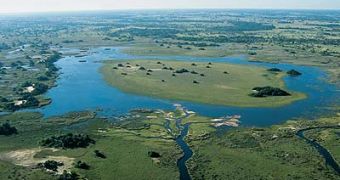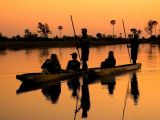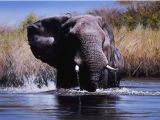This is a geographic accident located in the desert sands of the Kalahari (Botswana) like the mouth of a large river: a lot of streams and small lakes forming a wet labyrinth where you can see herds of buffaloes and elephants and lions stalking their prey.
But the peculiarity of the Okavango is the way it dies. The river springs from the central Angola and after running 1,400 km (880 mi), it literally evaporates in the Kalahari desert, its mouth turning into the world's largest inner delta (15,000 square km, about five times larger than Danube Delta, for instance) and an exceptional place for seeing the most representative species of the African fauna. To the south, Okavango Delta fuels Lake Ngami.
During the rainy season, the volume of flow of its numerous arms and thousands of channels in which the river is divided while approaching its final increases significantly, receiving 11 cubic kilometers of water annually. The arrival of the water in a country representing the paradigm of the dryness is an event, that's why 'pula', Botswana's national currency means "water".
10,000 years ago, Okavango still flowed into the area of Makgadkgadi Pan, southern Botswana. The pan is an ancient lake turned today into vast plains of drought and gray land which only harbor water rarely, in years with extremely abundant rainfall.
Together with the omnipresent desert, the pans have been gaining terrain and they have pushed most of the population towards the cities.
Botswana has a surface almost as much as Texas and a little more than 1.5 million people, and it is surprisingly one of the countries with the greatest percentage of urban population in the world. Only the Bushmen still dare to defy the climate severity of the Kalahari. That's why, even if the territory occupied by the Okavango delta is relatively small, it harbors 90 % of Botswana's waters, a national treasure.
Like a store depositing reserves for the times of scarcity, the delta presents its highest water levels during the dry season, between May and July, and empties gradually reaching the rainy season with the minimum lows. That's why when there's no water, the animals start a migration to the wetlands of the river.
Your attention may be attracted by zebras or giraffes, but animals adapted to the Okavango delta are the Red Lechwe and Reedbucks, beautiful aquatic antelopes that cross the waters at a great speed. This is also one of the few places in Africa where the African Wild Dog can still be seen. The Okavango's lions are famous as the only ones in the world that do not avoid water and are adapted for hunting in the swamps. Numerous birds feed on the fish of the swamps, like spoonbillls, herons, ibises, and prey birds.
Traditionally, both locals and tourists use mokoro, a narrow canoe pushed with a perch, allowing a silent movement. Even if it may look dangerous to travel in mokoro amongst elephants, hippopotamuses and crocodiles, incidents are extremely rare.
The delta's vegetation is impressive. In many occasions, the water is covered by waterlilies, while the banks are covered by papyrus and palm trees. In the savanna around the delta, the dominant tree is the mopane, which in some places forms real forests.
The oasis can be reached by air or water, and Maun City is its operational center. Chief's Island, in the Moremi reserve, is one of the richest areas in fauna. The difficult access, and the high prices for entry and staying in the natural reserves have turned Botswana and Okavango in one of the most expensive destinations in Africa. In change, you can enjoy one of the least altered areas in the continent.

 14 DAY TRIAL //
14 DAY TRIAL // 

